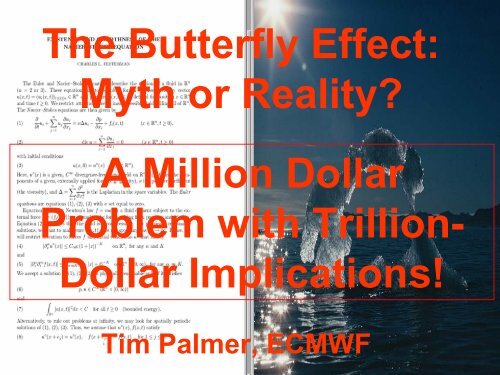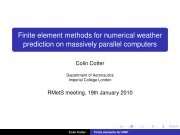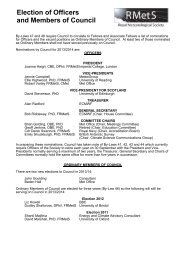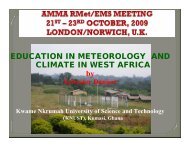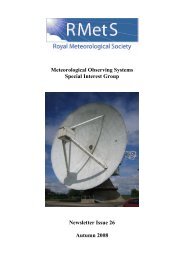The Butterfly Effect
The Butterfly Effect
The Butterfly Effect
You also want an ePaper? Increase the reach of your titles
YUMPU automatically turns print PDFs into web optimized ePapers that Google loves.
<strong>The</strong> <strong>Butterfly</strong> <strong>Effect</strong>:<br />
Myth or Reality?<br />
A Million Dollar<br />
Problem with Trillion-<br />
Dollar Implications!<br />
Tim Palmer, ECMWF
“<strong>The</strong> <strong>Butterfly</strong> <strong>Effect</strong> is a phrase that<br />
encapsulates the more technical<br />
notion of sensitive dependence on<br />
initial conditions in chaos theory”<br />
(Wikipedia)
dX<br />
dt<br />
dY<br />
dt<br />
dZ<br />
dt<br />
=− σX<br />
+ σY<br />
=− XZ + rX −Y<br />
= XY −bZ<br />
Lorenz 1963<br />
Exhibits sensitive but nevertheless continuous<br />
dependence on initial conditions – you tell me how<br />
accurately you want to know the forecast state, I’ll tell you<br />
how accurately you need to know the initial conditions.<br />
I believe this is not what Lorenz had in mind by “<strong>The</strong><br />
<strong>Butterfly</strong> <strong>Effect</strong>” – he had in mind systems without<br />
continuous dependence on initial conditions – these<br />
exhibit a much more radical type of unpredictability.
Lorenz. <strong>The</strong> Essence of Chaos (1993)<br />
“<strong>The</strong> expression (<strong>The</strong> <strong>Butterfly</strong> <strong>Effect</strong>) has a somewhat<br />
cloudy history: It appears to have arisen following a<br />
paper that I presented at a meeting in Washington in<br />
1972, entitled: Does the Flap of a <strong>Butterfly</strong>’s Wings in<br />
Brazil Set Off a Tornado in Texas…..<br />
…Before the Washington meeting I had sometimes<br />
used a sea gull as a symbol for sensitive dependence.<br />
<strong>The</strong> switch to a butterfly was actually made by the<br />
session convener .. who was unable to check with me<br />
when he had to submit the program titles”
“<strong>The</strong> following is the text of a talk I presented …in Washington..on<br />
1972…in its original form<br />
Predictability:Does the Flap of a <strong>Butterfly</strong>’s Wings in Brazil<br />
Set Off a Tornado in Texas?<br />
…<strong>The</strong> most significant results are the following:<br />
1. Small errors in the coarser structure of the weather patterns…tend<br />
to double in about three days..<br />
2. Small errors in the finer structure, eg the positions of individual<br />
clouds- tend to grow much more rapidly, doubling in hours or less…<br />
3. Errors in the finer structure, having attained appreciable size, tend to<br />
induce errors in the coarser structure. This result...implies that after<br />
a day or so there will be appreciable errors in the coarser structure.<br />
Cutting the observational error in the finer structure in half – a<br />
formidable task - would extend the range of acceptable prediction of<br />
even the coarser structure only by hours or less...”<br />
Lorenz: <strong>The</strong> Essence of Chaos
Tellus 1969
“It is proposed that certain formally<br />
deterministic fluid systems which possess<br />
many scales of motion are observationally<br />
indistinguishable from indeterministic systems;<br />
specifically that two states of the system<br />
differing initially by a small “observational<br />
error” will evolve into two states differing as<br />
greatly as randomly chosen states of the<br />
system within a finite time interval, which<br />
cannot be lengthened by reducing the<br />
amplitude of the initial error…..”<br />
Lorenz 1969
Let Ek ( ) denote the kinetic energy per unit<br />
wave number of the system at wave number<br />
k<br />
−3/2 −1/2<br />
Eddy "turn over" time τ ( k) : k E ( k)<br />
<strong>The</strong> time taken for some initial small-scale error<br />
to grow and nonlinearly infect some large-scale<br />
component k , N powers of 2 larger in scale,<br />
N<br />
n<br />
( N) τ ( 2 k )<br />
Ω =∑<br />
n=<br />
0<br />
L<br />
L<br />
:<br />
:
−5/3 2/3<br />
If Ek ( ) k then τ<br />
−<br />
: ( k)<br />
: k an<br />
N<br />
∑<br />
n<br />
Ω ( N) = τ (2 k )<br />
n=<br />
0<br />
L<br />
N<br />
2 /3<br />
( ) ∑<br />
− n<br />
L<br />
2 : τ<br />
L)<br />
n=<br />
0<br />
= τ k ( k as<br />
N →∞<br />
d
<strong>The</strong> “Real <strong>Butterfly</strong> <strong>Effect</strong>”<br />
Error<br />
Increasing scale<br />
<strong>The</strong> Predictability of a Flow Which Possesses Many<br />
Scales of Motion. E.N.Lorenz (1969). Tellus.<br />
Cf G.D.Robinson 1967
Ek ( )<br />
:<br />
3<br />
k −<br />
Ek ( )<br />
:<br />
5/3<br />
k −<br />
Atmospheric Wavenumber Spectra
“We have not been able to prove or disprove our<br />
conjecture, since in order to render the<br />
appropriate equations tractable we have been<br />
forced to introduce certain statistical<br />
assumptions which cannot be rigorously<br />
defended.”<br />
Lorenz 1969
Clay Mathematics Institute<br />
Millenium Million-Dollar Prize<br />
Problems<br />
• Birch and Swinnerton-Dyer Conjecture<br />
• Hodge Conjecture<br />
• Navier-Stokes Equations<br />
• P vs NP<br />
• Poincaré Conjecture<br />
• Riemann Hypothesis<br />
• Yang-Mills <strong>The</strong>ory
Clay Mathematics Institute<br />
Millenium Million-Dollar Prize<br />
Problems<br />
• Birch and Swinnerton-Dyer Conjecture<br />
• Hodge Conjecture<br />
• Navier-Stokes Equations<br />
• P vs NP<br />
• Poincaré Conjecture<br />
• Riemann Hypothesis<br />
• Yang-Mills <strong>The</strong>ory
Navier-Stokes Equations<br />
For smooth initial conditions<br />
and suitably regular<br />
boundary conditions<br />
do there exist smooth,<br />
solutions at all future<br />
times?
<strong>The</strong> Millenium Navier-Stokes<br />
problem concerns the finite-time<br />
downward cascade of energy to<br />
arbitrarily small scales.<br />
An equivalent description of the<br />
problem is in terms of the finitetime<br />
upscale cascade of error<br />
from arbitrarily small scales, ie<br />
the ”Real <strong>Butterfly</strong> <strong>Effect</strong>”!
Climate Change is the<br />
“defining issue of our era*”<br />
*Ban Ki Moon UN Secretary General
….. and a trillion-dollar problem<br />
(Stern Review on the Economics<br />
of Climate Change)
Standard Paradigm for a Weather/ Climate Model<br />
⎛ ∂ ⎞<br />
ρ⎜<br />
+ ∇ ⎟ = ρ −∇ + ν ∇<br />
⎝∂t<br />
u ⎠<br />
u g u<br />
2<br />
. p , ...<br />
X X ...<br />
1<br />
X<br />
2 3<br />
...<br />
X<br />
n<br />
Increasing scale<br />
Eg Clouds, radiation,<br />
small-scale topography..<br />
Local bulk-formula<br />
parametrisation<br />
P X<br />
( )<br />
n ;<br />
α<br />
to represent<br />
unresolved processes
20-km resolution
80-km resolution
320-km resolution
<strong>The</strong> “Real <strong>Butterfly</strong> <strong>Effect</strong>” raises fundamental<br />
unanswered questions about convergence of<br />
climate simulations with increasing resolution:<br />
1. How much will uncertainties in climate-change<br />
predictions reduce if models are run at 20km, 2km or<br />
even 0.2km resolution rather than say 200km<br />
resolution?<br />
2. Is there an irreducible level of uncertainty in<br />
predictions of climate change associated with the<br />
underlying PDEs of climate?<br />
3. What is the most efficient way of using finite<br />
computer resources for climate prediction – eg how to<br />
partition resources between resolution, earth-system<br />
complexity and ensemble size?
Conclusions<br />
• By the “<strong>Butterfly</strong> <strong>Effect</strong>”, Lorenz had something<br />
more radical and more unpredictable than just<br />
sensitive dependence on initial conditions.<br />
• <strong>The</strong> “Real <strong>Butterfly</strong> <strong>Effect</strong>” refers to the problem of<br />
high-dimensional fluid turbulence in PDEs<br />
• Myth or Reality? <strong>The</strong> Real <strong>Butterfly</strong> <strong>Effect</strong> is<br />
unproven and the subject of a million-dollar<br />
mathematics prize.<br />
• <strong>The</strong> “Real <strong>Butterfly</strong> <strong>Effect</strong>” is relevant to assessing<br />
our ability to predict climate change – a trilliondollar<br />
problem!


